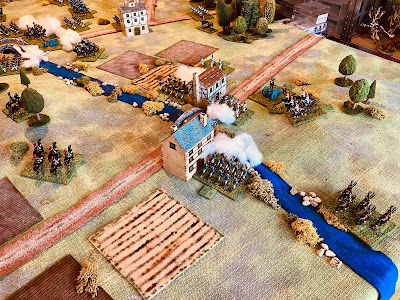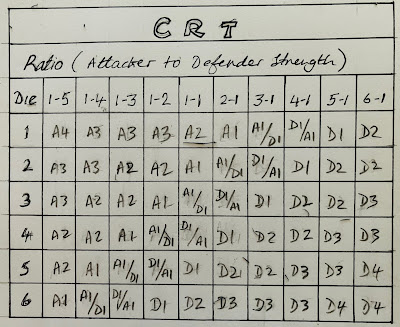Over the past week I have been cleaning up some old samurai MiniFigs and Dixon samurai miniatures that I painted way back in the 1980’s. This cleaning up got me wanting to get my existing Samurai collection of miniatures onto the tabletop for a game. I opted to play the Battle of Sekigahara, 1600, using the scenario from the Junior General website, the game pits Ishida Mitsunari's seven-unit Western army against Tokugawa Ieyasu's six-unit Eastern army. One of the Western unit’s loyalty is suspect and could potentially switch sides during the game and join the Eastern forces.
 |
| The Sekigahara game set up. Red units representing the eastern army and Blue for the Western army. |
I typically use a variation of One-Hour Wargaming's pike and musket rules when playing Samurai games, but I decided against using them for this battle due to its large scale, and how the armies involved were organisated around the self-contained units called Sonae. Where each Sonae is led by a clan Daimyo and contains a mix of troop types, including bowmen, arquebuses, Ashigaru spearmen, and samurai warriors.
 |
| A close up showing the mix of miniatures. |
So what to do with the rules when you have only 6 units which are essentially identical with a combination of arquebuses, Ashigaru spearmen, and samurai?
The game as the potential to be very boring with no unit differentiation and units operating in the same manner. Well I turned to a rather unexpected set of rules for inspiration - Ganesha Games “Samurai Robots Battle Royale” rules.
 |
| Ganesha Games Rules |
At this point you may be asking have I lost my marbles? But there are similarities between how a robot and a unit (Sonae) operate. Both have missile capabilities (Sonae have bow and arquebus) and combat capabilities (Sonae have Ashigaru spear and samurai).
For this game, a typical Sonae would consist of 3 missile bases combining 1 bow base and 2 arquebuses, 3 Ashigaru bases, and 2 Samurai bases. The overall commander would be added to one of the Sonae, bringing its samurai count to three.
 |
| On the left a Sonae with 8 bases: 2 samurai, 3 Ashigaru spears, 2 arquebuses, and 1 bow. On the right a Sonae with an additional commander and so fields an additional samurai unit. |
Despite the similarity of Sonae on both sides, Ganesha Games' activation system adds a layer of choice and risk taking to the gameplay. On your turn, you can activate a Sonae by rolling one, two, or three dice. Each dice score that equals or exceeds the model's Quality score allows you to execute an action for that unit. However, for each failed activation roll, the other player gets an opportunity to react immediately. This back-and-forth between activation and reaction keeps the game both interesting and unpredictable. If you happen fail two or more dice then your turn is over and it’s the other player’s turn.
In most cases a Sonae’s quality score is 3+ and reflects how loyal a Daimyo is to the lord they are aligned to, but this can be set at 4+ where a Daimyo’s loyalty is questionable. When rolling for reactions a 4+ is required and no unit can react more than once in a turn.
The possible actions a unit can take are:
- Shooting: Place any missile bases in the front row. If the target is within 12 inches, roll 1D6 and add the number of available arquebus bases in the front row. The target rolls 1D6 and adds the number of bow bases*. If the attacker's total score is higher, the defender removes one base of their choice from the front row. (Costs 1 action)
- Aimed Shooting: Same as shooting, but the attacker chooses the base to be removed from the front row. (Costs 2 actions)
- Assault: Place any combat bases (Ashigaru or Samurai) in the front row. Move 6 inches into contact with the target Sonae and roll 1D6, adding the number of combat bases in the front row (1 for each Ashigaru base and 2 for each Samurai base). If the attacker's total score is higher, the defender removes one base of their choice from the front row. (Costs 1 action)
- Targeted Assault: Same as assault, but the attacker chooses the base to be removed from the front row. (Costs 2 actions)
- Move: Move 6 inches, or 3 inches across difficult terrain (e.g., rivers). (Costs 1 action)
Note - * bows were often used to keep the enemy heads down while the arquebuses reloaded.
During a player's turn, they can rearrange the bases within a Sonae once following a successful activation. However, each Sonae must always maintain three bases in its front line. Replace any front line gaps immediately with another base.
A Sonae is considered eliminated when either it is reduced to fewer than three bases or it has no remaining Samurai bases.
Flank and rear attacks are always directed against the second and third rows of a Sonae. When defending against a flank or rear attack the defending player must select three bases, if possible, to counter the attack. If a Sonae only has a front row, it cannot be attacked by either shooting or assault. It is all to confused for an attacker to be effective.
To disengage from a melee, a Sonae can move away from the opponent, but this action prohibits any shooting or assault attacks by it during the player’s turn.
The game report…
The clash between the rival Western and Eastern factions takes place on October 21, 1600, near the town of Sekigahara. Both armies are evenly matched with six loyal Sonae per army. The Western forces commanded by Ishida Mitsunari are represented by the blue army, and the Eastern forces commanded by Tokugawa Ieyasu by the red army. The loyalty of Kobayakawa Hideaki is unknown at the start of the game. When the loyalty becomes known using dice rolls (see the Junor General scenario) the Sonae will appear on the left flank of the Eastern army.
 |
| The tabletop setup. Hideaki’s Sonae will appear on the far flank once their loyalty is determined. Until then both armies will have to be wary of committing too much on that flank. |
Opening moves…
The Eastern army initiate the battle, advancing towards the Western army's left flank, seeking to engage their forces between Mount Samao and Mount Tengu. The Western army responded swiftly, launching a counter attacks to halt the Eastern army's momentum. Both commanders, Tokugawa Ieyasu and Ishida Mitsunari, remained wary of Kobayakawa Hideaki's loyalties, maintaining a prudent distance from Mount Matsuo, where Hideaki's formidable clan is positioned.
 |
The Eastern army surges forward, their ranks bristling with arquebuses. As the distance between the two armies narrows, a hail of musket balls erupts, sending plumes of smoke across the battlefield. These initial exchanges marked the opening phase of the battle.
|
 |
| In response to the Eastern army's initial advance, Sonae of the Western army launches a series of counter attacks. Their Sonae charge forward, seeking to break through the Eastern lines and disrupt their formations. |
 |
| In a bold move the Western army shifts an additional Sonae to their left flank, aiming to bolster their counter attacks against the Eastern army's initial advance |
Mid-game…
Kobayakawa Hideaki allegiances are revealed as he throws his support behind Tokugawa Ieyasu and the Eastern army. This act of treachery forces Mitsunari's to hastily redeploy his forces to counter the impending flank attack from Hideaki's formidable Sonae. Mitsunari's only remaining option is to redouble his efforts in an attempt to break through the Eastern army's left flank, a gamble that will determine the fate of the battle.
 |
| In a dramatic shift of momentum, Kobayakawa Hideaki's forces, having declared their allegiance to the Eastern army, descend from Mount Matsuo and enter the battle. |
 |
| The arrival of Hideaki on the battlefield marks a turning point, as they charge forward into the Western army's flank. This unexpected move forces the Western forces to redeploy and threatens to overwhelm their right flank. |
 |
The Western army's relentless counter attacks had forced the Eastern army to cede ground. Tokugawa Ieyasu, recognising the growing threat to his right, is compelled to lead his own Sonae into the fray, seeking to stem the tide and restore order to his beleaguered troops.
The end game…The Western army's right flank, already weakened by Hideaki's treacherous defection, finally crumbled under the relentless pressure of the Eastern army's superior numbers. The sudden collapse of their flank irreparably damages the Western army's cohesion, rendering them vulnerable to a decisive defeat. |
 |
| The Western army's right flank finally succumbs to superior numbers. |
 |
| Tokugawa Ieyasu's timely intervention with his Sonae proved crucial in stabilizing the Eastern army's right flank, effectively countering the Western army's gains. Despite their valiant counterattacks, the Western forces were unable to breach the Eastern army's defensive line. |
Eastern Army Victory
A victory to the Eastern army commanded by Tokugawa Ieyasu, which was made all the more possible by Hideaki's defection.
For either side to win victory without Hideaki’s support they must gain some early momentum and break through the opponents defence and cause confusion. Else defeat seems inevitable.
Anyway a most enjoyable scenario which go me taking a different path for the rules.
Summary…
So did the rules work? The rule variant certainly provided an engaging and interesting gaming experience where the units were identical in their make up. Tactically employing arquebuses for ranged attacks and manoeuvring, or risk taking, for opportune close-quarters combat presented a few interesting moments in the game. Similarly, the use of powerful samurai bases to gain advantage in melee poses a risk of their loss and the potential impact on their Sonae’s morale, added another layer of complexity to decision making.
I intend to try and take these rules further with a few more games and also try playing with some variations in Sonae unit composition, such as increasing the proportion of missile bases and reducing combat bases, or the reverse. Replicating the diverse troop arrangements of Samurai armies of the period.
A couple of interesting blogs I found while preparing for this game:
















































